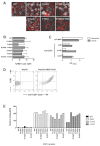In silico directed mutagenesis identifies the CD81/claudin-1 hepatitis C virus receptor interface
- PMID: 22897233
- PMCID: PMC3549482
- DOI: 10.1111/cmi.12008
In silico directed mutagenesis identifies the CD81/claudin-1 hepatitis C virus receptor interface
Abstract
Hepatitis C virus (HCV) entry is dependent on host cell molecules tetraspanin CD81, scavenger receptor BI and tight junction proteins claudin-1 and occludin. We previously reported a role for CD81/claudin-1 receptor complexes in HCV entry; however, the molecular mechanism(s) driving association between the receptors is unknown. We explored the molecular interface between CD81 and claudin-1 using a combination of bioinformatic sequence-based modelling, site-directed mutagenesis and Fluorescent Resonance Energy Transfer (FRET) imaging methodologies. Structural modelling predicts the first extracellular loop of claudin-1 to have a flexible beta conformation and identifies a motif between amino acids 62-66 that interacts with CD81 residues T149, E152 and T153. FRET studies confirm a role for these CD81 residues in claudin-1 association and HCV infection. Importantly, mutation of these CD81 residues has minimal impact on protein conformation or HCV glycoprotein binding, highlighting a new functional domain of CD81 that is essential for virus entry.
© 2012 Blackwell Publishing Ltd.
Figures




Similar articles
-
Claudin association with CD81 defines hepatitis C virus entry.J Biol Chem. 2010 Jul 2;285(27):21092-102. doi: 10.1074/jbc.M110.104836. Epub 2010 Apr 7. J Biol Chem. 2010. PMID: 20375010 Free PMC article.
-
CD81 and claudin 1 coreceptor association: role in hepatitis C virus entry.J Virol. 2008 May;82(10):5007-20. doi: 10.1128/JVI.02286-07. Epub 2008 Mar 12. J Virol. 2008. PMID: 18337570 Free PMC article.
-
Hepatitis C virus induces CD81 and claudin-1 endocytosis.J Virol. 2012 Apr;86(8):4305-16. doi: 10.1128/JVI.06996-11. Epub 2012 Feb 8. J Virol. 2012. PMID: 22318146 Free PMC article.
-
Structural characterization of CD81-Claudin-1 hepatitis C virus receptor complexes.Biochem Soc Trans. 2011 Apr;39(2):537-40. doi: 10.1042/BST0390537. Biochem Soc Trans. 2011. PMID: 21428935 Review.
-
Hepatitis C virus entry into host cells.Cell Mol Life Sci. 2008 Jan;65(1):100-12. doi: 10.1007/s00018-007-7291-8. Cell Mol Life Sci. 2008. PMID: 17914604 Free PMC article. Review.
Cited by
-
Regulation of cytoskeleton and adhesion signaling in osteoclasts by tetraspanin CD82.Bone Rep. 2019 Jan 30;10:100196. doi: 10.1016/j.bonr.2019.100196. eCollection 2019 Jun. Bone Rep. 2019. PMID: 30788390 Free PMC article.
-
Claudin-2 pore function requires an intramolecular disulfide bond between two conserved extracellular cysteines.Am J Physiol Cell Physiol. 2013 Jul 15;305(2):C190-6. doi: 10.1152/ajpcell.00074.2013. Epub 2013 May 15. Am J Physiol Cell Physiol. 2013. PMID: 23677799 Free PMC article.
-
CD81-receptor associations--impact for hepatitis C virus entry and antiviral therapies.Viruses. 2014 Feb 18;6(2):875-92. doi: 10.3390/v6020875. Viruses. 2014. PMID: 24553110 Free PMC article. Review.
-
Hepatitis C virus infection and tight junction proteins: The ties that bind.Biochim Biophys Acta Biomembr. 2020 Jul 1;1862(7):183296. doi: 10.1016/j.bbamem.2020.183296. Epub 2020 Apr 5. Biochim Biophys Acta Biomembr. 2020. PMID: 32268133 Free PMC article. Review.
-
CD81 and hepatitis C virus (HCV) infection.Viruses. 2014 Feb 6;6(2):535-72. doi: 10.3390/v6020535. Viruses. 2014. PMID: 24509809 Free PMC article. Review.
References
Publication types
MeSH terms
Substances
Grants and funding
LinkOut - more resources
Full Text Sources

